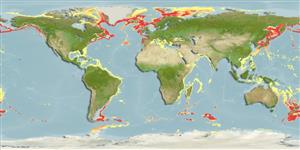Polychaeta |
Eunicida |
Onuphidae
Environment: milieu / climate zone / εύρος βάθους / distribution range
Οικολογία
; εύρος βάθους 48 - 1500 m (Αναφ. 75621). Tropical
Indo-West Pacific, Atlantic Ocean, Arctic and the Mediterranean Sea: Central America to northern Brazil and Svalbard.
Length at first maturity / Μέγεθος / Weight / Age
Γεννητική Ωρίμανση: Lm ? range ? - ? cm Max length : 10.0 cm TL αρσενικό/απροσδιόριστο; (Αναφ. 75621)
Length based on occurrence record; to be replaced with better reference. Minimum depth based on Ref. 116516.
Life cycle and mating behavior
Γεννητική Ωρίμανση | Αναπαραγωγή | Γεννοβολία | Eggs | Γονιμότητα | Larvae
Members of the class Polychaeta are mostly gonochoric (sexual). Mating: Females produce a pheromone attracting and signalling the males to shed sperm which in turn stimulates females to shed eggs, this behavior is known as swarming. Gametes are spawned through the metanephridia or body wall rupturing (termed as "epitoky", wherein a pelagic, reproductive individual, "epitoke", is formed from a benthic, nonreproductive individual, "atoke"). After fertilization, most eggs become planktonic; although some are retained in the worm tubes or burrowed in jelly masses attached to the tubes (egg brooders). Life Cycle: Eggs develop into trocophore larva, which later metamorph into juvenile stage (body lengthened), and later develop into adults.
Bisby, F.A., Y.R. Roskov, T.M. Orrell, D. Nicolson, L.E. Paglinawan, N. Bailly, P.M. Kirk, T. Bourgoin and J. van Hertum (eds.) 2008 Species 2000 & ITIS Catalogue of Life: 2008 Annual Checklist. CD-ROM; Species 2000: Reading, U.K. (Αναφ. 75097)
IUCN Red List Status
(Αναφ. 130435: Version 2025-1)
CITES status (Αναφ. 108899)
Not Evaluated
Not Evaluated
Threat to humans
Human uses
| FishSource |
Εργαλεία
Περισσότερες πληροφορίες
Τροφική ΟικολογίαFood items (preys)Σύσταση δίαιταςΚατανάλωση τροφήςΘηρευτές Life cycleΑναπαραγωγήΓεννητική ΩρίμανσηΓονιμότηταΓεννοβολίαEggsEgg developmentLarvae PhysiologyΚατανάλωση οξυγόνου
Human RelatedStamps, coins, misc.
Διαδικτυακές πηγές
Estimates based on models
Preferred temperature
(Ref.
115969): 0.7 - 9.9, mean 3.6 (based on 1112 cells).
Fishing Vulnerability
Low vulnerability (10 of 100).
Price category
Unknown.
